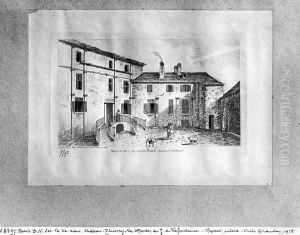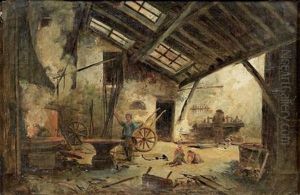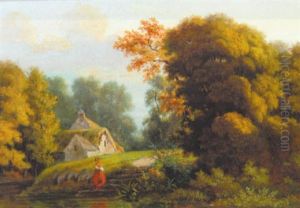Charles Nicolas Ransonnette Paintings
Charles Nicolas Ransonnette was a French artist and lithographer born in 1793 in Paris, France. He was known for his contributions to the field of lithography, a printmaking technique that was relatively new at the time and which he helped to popularize in France. Ransonnette's work spans a diverse range of subjects, including architectural views, landscapes, and genre scenes, reflecting the artistic movements and societal shifts of his time.
Ransonnette received his artistic training under the guidance of his father, who was also an artist, and he further developed his skills and techniques through his studies at the École des Beaux-Arts in Paris. Early in his career, he focused on painting, but he quickly recognized the potential of lithography as a medium for artistic expression and reproduction. This interest likely stemmed from the growing popularity of lithography, which allowed artists to produce high-quality prints that could be widely distributed, making art more accessible to the public.
Throughout his career, Ransonnette produced a significant number of lithographs, which were well-received by both critics and the public. His attention to detail and his ability to capture the essence of the subjects he portrayed contributed to his reputation as a skilled lithographer. He was particularly adept at depicting the architectural marvels of Paris and other French cities, offering a visual record of urban life and the transformation of the cityscape during a period of rapid modernization.
Ransonnette's interest in architecture also led him to publish several collections of lithographs that focused on the historic buildings and monuments of France. These collections were not only important artistic contributions but also served as valuable historical documents, capturing the appearance of various sites before the advent of photography.
Despite his success as a lithographer, Ransonnette's work as a painter should not be overlooked. He exhibited his paintings at the Salon de Paris, an official art exhibition of the Académie des Beaux-Arts, which was the most prestigious art event in France at the time. His paintings, like his lithographs, often depicted everyday scenes and landscapes, rendered with sensitivity to light and atmosphere.
Charles Nicolas Ransonnette passed away in 1877, leaving behind a legacy as a prominent figure in the development of lithography in France. His works continue to be studied and appreciated for their historical value and artistic merit, providing insight into the cultural and urban transformations of 19th-century France.


